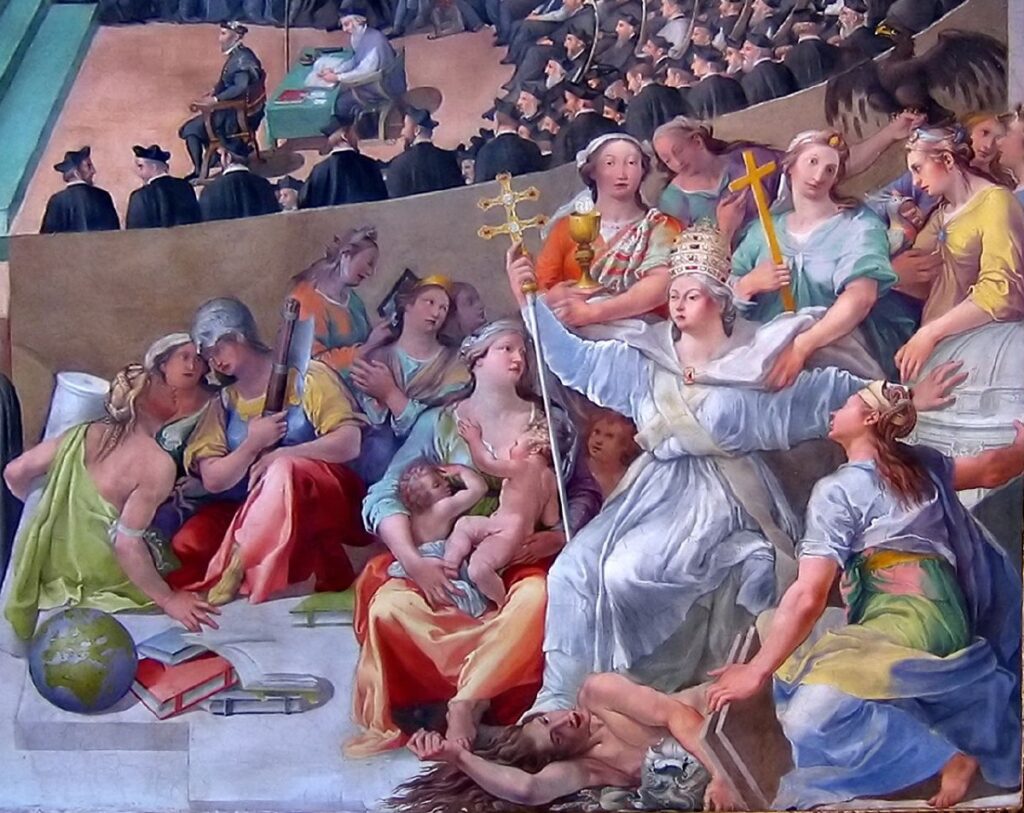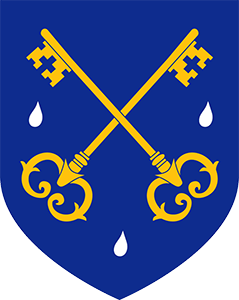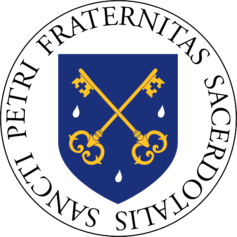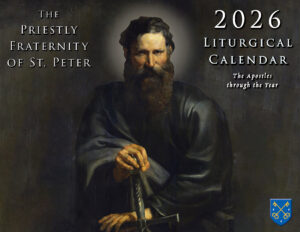Joy that One is Born into the World
By Fr. William Rock, FSSP
It seems that after the two-and-a-half-weeks of Septuagesima, the 40 fasting days of Lent, the 50 days of Easter, and then the Octave of Pentecost and Trinity Sunday, Our Holy Mother, the Church, is not yet ready to leave behind the mysteries she has been meditating upon during those times. She, as it were, turns her gaze backwards and renews, recapitulates, some of the most profound moments of the Easter Cycle, but this time, not with Our Lord’s impending Passion and Death before her, but rather with His glorious Resurrection and Ascension behind her.

She begins this backwards gaze on the Thursday following Trinity Sunday. A Thursday because here she recapitulates Holy Thursday. Holy Thursday itself commemorates so many things – the Last Supper with the Washing of the Feet, the Institution of the Sacrifice and the Priesthood of the New Law, the betrayal of Judas, Our Lord’s Agony and Capture in the Garden. It was God Himself, in a vision to St. Juliana, Who established which of the aspects of Holy Thursday was to be recapitulated.1 On the Thursday of Corpus Christi, then, the Church, through the lens of the Resurrection and Ascension, places her focus on the Holy Eucharist, one of the themes of Holy Thursday, and all that It means to her. Churches resound with the joyful chants and hymns of this feast, especially those which accompany the Eucharistic Procession where the Blessed Sacrament, no longer hidden under a veil as on Holy Thursday, is held aloft in triumph for all to see. But a one-day celebration could not satisfy the Church’s desire or exhaust the loving devotion she wished to lavish upon this great gift. As such, when the feast of Corpus Christi was instituted in 1264, it was instituted with an octave.2
This Octave having run from a Thursday to a Thursday, the Church finds herself on Friday. How could this not bring to her mind that Friday which followed Holy Thursday, Good Friday? But this Friday is not shrouded in sorrow as Good Friday was, but rather, now that He is Risen, it is vested in joy and celebration. Just as with the celebration of Corpus Christi, it was God Himself Who directed what would be the focus of the devotion of this recapitulated Good Friday. According to St. Margaret Mary Alacoque, Our Lord asked that a Feast of the Sacred Heart, the Heart which was pierced on Good Friday, be celebrated on the Friday following the Octave of Corpus Christi.3 Established in 1856, the Feast of the Sacred Heart was extended with an octave in 1928, allowing the Church to tarry in her sentiments and devotion here also.4, 5

On the Feast of the Sacred Heart, the Gospel reading comes from St. John’s Passion account, the same account read on Good Friday. The Gospels of Corpus Christi and of Holy Thursday also come from the Fourth Gospel. In the Gospel account for the Feast of the Sacred Heart, John’s eye-witness account of Our Crucified Lord’s side being pierced by a lance is presented to the Faithful. When it was read on Good Friday, it was related as part of the horror of that day. But now, in the light of His Resurrection and Ascension, the Church joyfully recalls something glorious.
For the Church sees in the water and blood which flowed forth from that pierced and opened Heart her own formation, her own birth. For just as Eve, the spouse of Adam, was formed from His side while He was asleep, so was the Church, the spouse of the new Adam, formed from the side of Our Lord as He slept the sleep of death on the Cross – “Then the Lord God cast a deep sleep upon Adam: and when he was fast asleep, he took one of his ribs, and filled up flesh for it. And the Lord God built the rib which he took from Adam into a woman” (Gen 2:21-22). St. Thomas Aquinas, in his commentary on this Gospel passage, wrote the following: “This event,” the transfixion of Our Lord’s Heart, “was also prefigured, for just as from the side of Christ, sleeping on the cross, there flowed blood and water, which makes the Church holy, so from the side of the sleeping Adam there was formed the woman, who prefigured the Church.”
In his commentary, Cornelius a Lapide wrote that “Sts. Cyril and Chrysostom say, that the water signifies Baptism, which is the first beginning of the Church and the other sacraments, and the blood represents the Eucharist, which is the end and completion of the sacraments, to which they all refer as to their beginning and their end.” The flowing blood symbolizing the Eucharist is another manner in which Holy Thursday and Good Friday and also Corpus Christi and the Feast of the Sacred Heart are united.
Baptism, as was quoted, is the “first beginning” of all of the Sacraments as the Baptismal Character is necessary to receive any of the other Sacraments. But how is it that the Eucharist is the completion and end of the other Sacraments? St. Thomas explains how all of the other Sacraments are ordered to the Eucharist as follows (S.T. III, q. 65, a. 3, c):
All the other sacraments seem to be ordained to this one as to their end. For it is manifest that the sacrament of [holy] order[s] is ordained to the consecration of the Eucharist: and the sacrament of Baptism to the reception of the Eucharist: while a man is perfected by Confirmation, so as not to fear to abstain from this sacrament. By Penance and Extreme Unction man is prepared to receive the Body of Christ worthily. And Matrimony at least in its signification, touches this sacrament; in so far as it signifies the union of Christ with the Church, of which union the Eucharist is a figure.
But why is it said that this flowing water and blood, representing Sacraments, mark the formation of the Church? A Lapide wrote that “S. Chrysostom and Theophylact say, ‘The Church exists and consists by means of the sacraments.’ For it is born by Baptism, strengthened by Confirmation, fed and perfected by the Eucharist, healed by Penance, fortified by Extreme Unction, governed by Holy Orders, and continued and extended by Matrimony.”

This idea that the Church was formed when the Sacred Heart of Our Savior was opened is not something imposed, forced onto the celebration of the Sacred Heart. For in the third stanza of the Vespers Hymn for the Feast of the Sacred Heart, the Church sings of herself: “From that pierced Heart was born the Church united with Christ: that entrance was made in the side of the Ark for the salvation of the human race.” The next stanza of the hymn, according with the present considerations, sings of the seven Sacraments – “From It unfailing grace flows forth like a sevenfold flood, that therein, in the Blood of the Lamb, we may wash our sullied robes.” 6 In her night office, that of Matins, for the commentary on the feast’s Gospel, the Church draws from the works of St. Bonaventure, Doctor of the Church. The commentary begins: “In order that the Church might be taken out of the side of Christ, in his deep sleep on the Cross…”7 The Church, then, was born on Good Friday during the Passion of the Lord from His pierced side.
As Our Lord explained, the pain of labor is forgotten and replaced with joy at the sight of the one who was brought into the world (see Joh 6:21). In a similar way, in the recapitulated Holy Thursday and Good Friday, the sorrow which accompanied these days of Holy Week is replaced with joy in the light of what these sufferings produced, the Church, the Bride, and her Sacraments. And it is this joy which Our Mother invites us to experience in the celebration of these feasts.
William Rock, FSSP was ordained in the fall of 2019 and is currently assigned to Regina Caeli Parish in Houston, TX.
- Guéranger, Prosper. The Liturgical Year, 10 (Time after Pentecost Book 1). Trans. Shepherd, Laurence. (Fitzwilliam: Loreto Publications, 2000), p. 137. See also the entry “Feast of Corpus Christi” in the Old Catholic Encyclopedia.
- See Encyclical Transiturus De Mundo (11 Aug 1264) of Urban IV.
- Guéranger, 429-430. See also the entry “Devotion to the Sacred Heart of Jesus” in the Old Catholic Encyclopedia.
- See Encyclical Caritate Christi Compulsi (3 May 1932) of Pius XI.
- During the liturgical changes carried out during the Pontificate of Pope Pius XII, the Octaves of both Corpus Christi and of the Sacred Heart were abolished, along with around 15 others, but a provision still exists in the 1962 Roman Missal that if a Eucharistic Procession is held, a Votive Mass of the Second Class of the Holy Eucharist may be celebrated on the days between Corpus Christi and the Feast of the Sacred Heart.
- Translation of this hymn can be found in Britt, Matthew. The Hymns of The Breviary and Missal. New York: Benziger Brothers, 1936.
- This translation can be found on The Divinum Officium Project.
June 8, 2023








